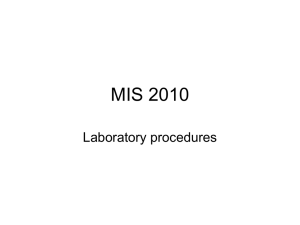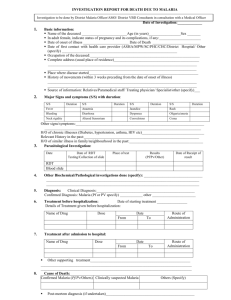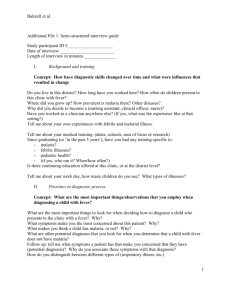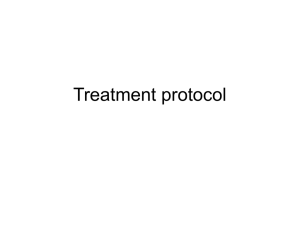Prices, Diagnostic Tests and the Demand for Malaria Treatment:
advertisement
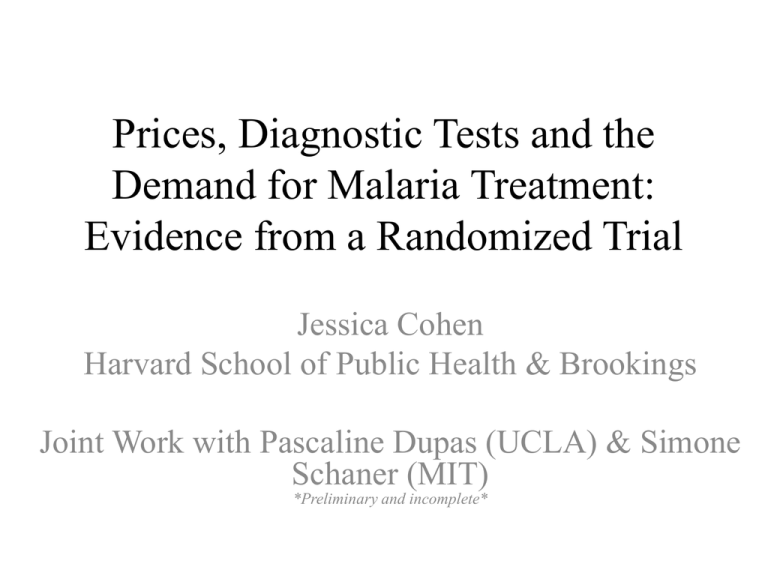
Prices, Diagnostic Tests and the Demand for Malaria Treatment: Evidence from a Randomized Trial Jessica Cohen Harvard School of Public Health & Brookings Joint Work with Pascaline Dupas (UCLA) & Simone Schaner (MIT) *Preliminary and incomplete* Current State of Malaria Control • Big donor $ and celeb campaigns (―veto the squito‖) helped scale up malaria prevention efforts in Africa – Wide scale bed net campaigns & spraying • Results have been mixed across countries, but evidence suggests declines in malaria-related mortality & morbidity • Malaria treatment efforts have made smaller strides • Currently < 15% of children under 5 with malaria are treated with effective medication Parasite Resistance & Rebounding Malaria • Gains made in 1960s-70s in GMEP; – DDT & Chloroquine (CQ) • CQ was cheap, effective & easy to produce • Public health message was to presumptively treat fever with CQ – prob(malaria|fever) was high & treatment was cheap – Simple message probably saved many lives • Widespread resistance in early 90s fueled rebounds in malaria morbidity & mortality seen in recent decades Malaria Parasite Resistance (Cont.) • Subsequent antimalarials (AQ, SP…) gotten more expensive & remain effective for less time • Only current effective antimalarial is Artemisinin • At $5-6 per dose, unaffordable to most living in SSA – Western Kenya, ave daily wage is $1.50 & 850 clinical episodes of malaria per 1000 ppl per year • This is price in retail sector (drug shops), where majority of Africans first seek treatment – Public facilities far, under-staffed & under-stocked • Even in public sector, Artemisinin often stocked out “Saving Lives, Buying Time” Proposed policy solution has gained consensus Produce Artemisinin Combination Therapies (ACTs), subsidize them enough to encourage market-share —Crowd out Artemisinin monotherapy & older, less effective treatments Objectives: 1) increase access to effective medication by drastically (95%) reducing price 2) stem resistance by encouraging combination therapy Implemented through the Affordable Medicines Facilitymalaria (AMFM) (Global Fund, WHO, DfID, etc.) —Roughly 95% subsidy on ACTs to first-line buyers Subsidy for ACTs • AMFm operate in pilot phase for 2 years in 8 countries (Africa + Cambodia) • Several unique elements of this approach: – Use price (subsidy) to regulate a global public good – Take importance of retail sector OTC treatment as given – Only regulate price at top of supply chain, reducing admin complexity & allowing final price to float • First best is to tax monotherapy according to use: – Not feasible, given heavy retail sector treatment – Also, ACT price reduction necessary in context of severe credit and cash constraints in malaria-endemic populations Access vs. Targeting Tradeoff • Subsidy this large likely to dramatically increase access to ACTs in Africa & stem resistance: – interruption of transmission – crowd-out monotherapy • However, also likely to dramatically increase inappropriate treatment w ACTs. Why? (1) Most people self-diagnose (fever, aches, etc.) and buy OTC medication (2) Even those going to facility usually treated based on clinical diagnosis (fever history) (3) Malaria control efforts have reduced the probability that fever = malaria (mostly caused by cold/flu or bacterial infection). Fever-based diagnosis almost no better than a random draw from the population at this point! Risks of Over-treatment • Treating a large number of non-malarial illness with ACTs is bad for several reasons: 1) Wastes subsidy money 2) Can accelerate resistance to artemisinin 3) Impedes learning about ACT (& ITN) effectiveness 4) Delays proper treatment for true cause of illness – Pneumonia leading cause of death for < 5’s. Many are mistakenly treated w/antimalarials. 5) Complicates estimates of global malaria burden & tracking progress of malaria control interventions Increasing access to malaria diagnostics can improve all of these Rapid Diagnostic Tests • RDTs have made expanded access to diagnosis a much easier proposition • Most health facilities in Africa do not have working microscopy + skilled lab technicians • These tests are highly accurate in field conditions, straightforward to learn & take 15 minutes • Already being used somewhat in public sector facilities Any attempt to increase access to diagnosis in Africa will have to consider use of RDTs in the private (retail) sector as well This Study: Increasing Access to Diagnostics in Kenya • We explore whether dual objectives of increased access & reduced over-treatment can be achieved 1) Make subsidized RDTs for malaria available alongside subsidized ACTs in rural drug shops 2) Create financial incentives for people to be diagnosed prior to purchasing ACTs • Main idea: if RDTs are accessible and priced properly wrt ACTs, people should want diagnosis – • Why waste money on ACTs and delay proper treatment? If RDTs successfully improve targeting of ACT subsidy to malaria-positive people, potentially cost-saving to subsidize RDTs as well Main Features of Experimental Design • Vouchers for ACTs & RDTs at randomly varying prices to households in catchment area of 4 drug shops • Some hhs got only ACT but were offered surprise test when came to redeem: – This tells us the extent to which ACT buyers under AMFm (which has no planned RDT subsidy) actually have malaria • Our primary interest is comparing AMFm world with and without subsidized RDTs along two dimensions: uptake of ACTs & targeting of ACTs to malaria-positive people 3 Key Questions: 1) What fraction of ACT buyers actually have malaria? 2) Can RDTs increase share of ACT buyers w/ malaria? 3) If so, is this cost-effective? Preview of Results • Uptake of ACTs not very price sensitive – Overall awareness that ACTs are more effective is low • Less than 40% of older children & adults for whom ACTs are bought test + • Positivity of ACT users increases with ACT price – Largely due to age composition of users (younger) at higher prices • RDTs are popular – Only minority of hh’s who buy ACTs do not redeem the RDT voucher first (at all RDT prices) Preview of Results (Cont.) • But RDTs only improve targeting modestly – Availability of subsidized RDTs increases the share of ACT buyers with malaria by 11 percent • This is because large share (60%) of people who test negative ignore results and buy ACTs anyway – Some could be keeping meds for later, but we have suggestive evidence that it’s because they don’t believe the test • Investing in strategies to improve adherence to test could be very cost-effective • Subsidizing RDTs becomes more cost-effective as: – They are used for older ages (especially older children & adults) – Endemicity is lower – Adherence to test results is higher Limitations • Only observe behavior for 4 months—can’t observe demand if no malaria episodes in hh – Malaria episodes balanced across treatment groups • Only could afford to give two vouchers—if had > 2 malaria episodes wanted to treat, we could underestimate demand – Might not be serious problem (<20% of hh’s redeem both vouchers) Overall, exact level and slope of demand curve may not be right And we are hoping to get estimates of clinical malaria arrival rates to do structural estimation Limitations (Cont.) • Cannot be precise about impact on ACT access overall, because no objective measure of crowd out – Have self-reported data but could have recall bias, social desirability bias, etc. – We have several reasons to believe crowd out was limited, from other study in this area & because public sector stocking of ACTs irregular Cannot say exactly what impact of AMFm (ACT subsidies) will be on ACT access overall But our focus is on comparing uptake & targeting of ACTs with & w/out an accompanying RDT subsidy, which is not compromised Study Design • 3 districts in Western Kenya (endemic malaria) • Rural, subsistence farmers, daily wage = $1.50 • Sampled every household within 4km radius of 4 drug shops for total of 2928 hhs • Vouchers could be redeemed at specific DS only, trained field officers posted at shop to sell ACTs & do RDTs • Randomization stratified by: 1) Drug Shop; 2) Distance of hh to drug shop; 3) Whether or not hh had children • Study duration 4 months; baseline survey (w/voucher distribution) & endline survey • Vouchers had no expiration date; bought back at endline Experimental Variation ACT Treatment Group RDT Treatment Group RDT Free RDT 15, Refund ACT 40 ($.50) ACT 60 ($.75) ACT 100 ($1.25) ACT 500 ($5; Control) Totals 169 177 173 0 519 0 239 233 0 472 242 237 241 0 720 343 754 342 995 343 990 189 189 1217 2928 RDT 15 No RDT Totals Why Vary ACT Prices? • Under AMFm final price is unknown and will likely vary: – Retail mark-ups of antimalarials in Africa are huge and variable • Our ACT price range captures range of prices of alternative antimalarials (lowest to highest quality) What is the impact of ACT price on uptake and on fraction of buyers who are malaria-positive (targeting)? Uptake: Measured by voucher redemption Malaria-positivity: Sub-sample of hhs got just ACT voucher, but offered surprise test when came to redeem 1) Gives fraction of ACT buyers testing positive under AMFm 2) Explores impact of ACT price on malaria-positivity ACT Voucher Pricing • Antimalarials are priced by dose (age) • ACT vouchers were randomized by ACT price per pill Recommended Dose and Corresponding Dose Cost for: Adult (14+) Ages 9-13 Ages 4-8 Ages 3m-3y 4 pills, twice a day for three days 3 pills, twice a day for three days 2 pills, twice a day for three days 1 pill, twice a day for three days Ksh 20.83 (Control) Ksh 500 ($5) Ksh 375 Ksh 250 Ksh 125 Ksh 4.16 Ksh 100 ($1.25) Ksh 60 ($.75) Ksh 40 ($.50) Ksh 75 Ksh 50 Ksh 25 Ksh 45 Ksh 30 Ksh 15 Ksh 30 Ksh 20 Ksh 10 Dose Price Per Pill Ksh 2.50 Ksh 1.66 Why Vary RDT Prices? • Can RDTs be made attractive with financial incentives? – Other barriers to diagnosis exist of course • So always price RDTs < ACTs & explore cases in which incentives should be most high-powered (1) RDT is free – If alternative is presumptive treatment, why not take RDT and avoid potential cost of ACT? (2) RDT price < ACT price, and refundable if test + – Pay same price as presumptive treatment if test +, and pay less than presumptive treatment if test – (3) RDT is cheap – More likely policy case w/ subsidized RDTs but shop owners make a margin Baseline Characteristics & Randomization Check Mean P-Value (ACT Treatment) (1) (2) Characteristics of Interviewed Household Head Age (years) 38.829 .027 Education (years) 5.451 .404 Literate 0.618 .527 Married 0.782 .398 Household Characteristics Number members 5.330 .293 Acres Land 2.232 .255 Distance from drug shop (km) 1.670 .837 Baseline Malaria Knowledge and Health Practices Number bednets 1.778 .548 Share HH Slept Under Net 0.577 .573 Heard of Coartem 0.424 .861 Heard of RDTs 0.144 .592 Hemoglobin Testing Any with Severe Anemia 0.545 .174 Any with Moderate Anemia 0.602 .038 P-Value (RDT Treatment) (3) .188 .017 .026 .071 .649 .138 .080 .217 .266 .397 .373 .168 .357 Treatment Seeking at Baseline Household Level (1) Episode Level (2) Overall Incidence (Past Month) Malaria Episodes/HH Member At Least One HH Member Had Malaria .246 .685 Public health facility Drug Shop Self .466 .176 .514 .366 .148 .459 No Antimalarial Taken Public health facility Drug Shop .292 .541 .558 .221 .345 .407 ACT Sulfadoxine-Pyrimethamine (SP) Amodiaquine (AQ) .307 .157 .272 .273 .128 .231 Took microscopy test Took RDT .251 .040 Total Antimalarial Cost (Ksh) 127 Diagnosis Channel (If Had Malaria Episode) Source of Antimalarials (If Had Malaria Episode) Type of Medication Taken (If Took Antimalarial) Testing (If Had Malaria Episode) Cost Per Episode (If Took Antimalarials) 131 In sum, baseline treatment seeking behavior suggests that people in this region of Kenya: • Have frequent malaria episodes • Typically self-diagnose or receive a clinical diagnosis without a blood test • Often buy medication from drug shops • Take ACTs a minority of the time • Have substantial out-of-pocket expenditures on malaria episodes ACT Take-Up • Not much price sensitivity • Big increase in ACT uptake in private sector from subsidy, but cannot infer impact on overall ACT access b/c some getting from public sector Second Voucher Redemptions Impact of ACT Price on Age Composition of Buyers • Important reason for low price sensitivity is vouchers being used for younger members at higher price classes Malaria Positivity by Age • The fact that the age of buyers declines with ACT price class has implications for targeting toward malaria positive people • Prob. of testing positive highly correlated w/ age • Among those buying ACTs in the surprise RDT group: – 80-90% of buyers under age 9 (2 lowest ACT dose groups) test positive – 40-50% over age 9 test positive • This is due to acquired immunity Local linear regression of positivity on age for surprise RDTs Malaria Positivity Increases w ACT Price Class Dependent Variable is: Tested Positive for Malaria All Adults/Teens Children/Infants (1) (2) (3) Specification 1: ACT Price Dummies (Ksh 40 Omitted) ACT 60 0.069 0.055 -0.013 (0.042) (0.085) (0.045) ACT 100 .089** 0.071 0.024 (0.045) (0.091) (0.046) Mean DV (omitted) 0.671 Specification 2: Linear ACT Price ACT Price .129* (0.071) Mean DV N 0.74 686 0.429 0.832 0.108 (0.156) 0.054 (0.070) 0.50 221 0.86 465 • 100Ksh ($1.25) increase in ACT price increases fraction of buyers who are malaria positive by 13 percentage points (18%) Other Selection Effects? • Positivity increases with ACT price partly b/c of age • Also likely that people willing to pay more for severe illness & more severe illness likely to be malaria • On the other hand, richer people might be healthier & able to afford higher priced ACTs • Overall no selection effects of ACT price on SES • Only find child’s HB to be decreasing significantly w/ price paid – Consistent with higher willingness to pay to treat more severe illness – But can’t make much of this given lack of significance on so many other variables Relationship b/t Demographics of ACT buyers & ACT Price Class Head education Head Literate Mother's Hb Child's Hb Acres land Permanent Roof Had Malaria Last Month Treats Water Regularly Distance to chemist Heard of Coartem Coefficient on ACT Price -0.420 (.503) -0.023 (.060) 1.229 (.946) -.843* (.499) -0.059 (.358) -0.048 (.068) -0.006 (.051) 0.128** (0.064) -0.006 (0.022) 0.066 (0.064) RDT Take-Up & Price Sensitivity • 37% of hh’s receiving an RDT voucher redeemed them, no difference across RDT prices – Or across ACT prices (i.e. people not more likely to use RDT when ACT price is higher) – In general, found no significant interaction effects so don’t report on them here • But RDTs popular in the sense that 80% of people coming to drug shop for any reason, used an RDT – That is, only 20% of hh’s that had RDT voucher and came to buy ACTs did not use the RDT voucher Impact of RDTs on ACT Targeting • Two ways availability of RDTs could influence targeting of ACT subsidy to malaria-positive people: 1) “Information Effects”: people who learn they are positive have higher willingness to pay for ACTs than those who learn they are negative 2) “Selection Effects”: impact of making RDTs available on who shows up to drug shop • • Could draw people from public sector Could draw people who otherwise would not seek treatment (DHS : > ½ of children with suspected malaria seek no treatment) • What does this mean for ACT targeting to malaria positive people? 1) Information Effects: improve targeting 2) Selection Effects: could go either way – – Availability of cheap, accessible RDTs could draw less sick people (less likely to have malaria) to drug shop Or could draw very sick people who would have gone to public sector Net effect of RDTs will depend on both Selection Effects • RDTs do not significantly increase treatmentseeking at drug shop Dependent Variable is: Sought Treatment Tested Positive for Malaria Conditional on Seeking Conditional on Unconditional Treatment Purchasing ACT (2) (3) (1) Specification 1: RDT Treatment Dummies (Omitted=No RDT) Free RDT 0.023 -0.028 0.042 (0.027) (0.047) (0.047) RDT 15, Refund 0.058** 0.055 0.067 (0.028) (0.052) (0.052) RDT 15 0.024 0.011 0.109** (0.024) (0.046) (0.045) Mean DV for Omitted 0.415 0.675 Specification 2: RDT Treatment Pooled (Omitted=No RDT) Any RDT 0.032 0.006 (0.020) (0.039) Mean DV for Omitted 0.415 0.675 N 2608 754 0.679 0.073* (0.039) 0.679 686 • RDTs have no significant effect on treatment seeking (Col. 1); • RDTs have no significant effect on positivity of those who seek treatment (Col. 2) Information Effects • Almost everyone who tests positive buys ACTs • Overall 65% of people who test negative buy ACTs; some variation across RDT treatment groups (but conf. intervals are large) Overall Impact of RDTs on Targeting Dependent Variable is: Sought Treatment Tested Positive for Malaria Conditional on Seeking Conditional on Unconditional Treatment Purchasing ACT (2) (3) (1) Specification 1: RDT Treatment Dummies (Omitted=No RDT) Free RDT 0.023 -0.028 0.042 (0.027) (0.047) (0.047) RDT 15, Refund 0.058** 0.055 0.067 (0.028) (0.052) (0.052) RDT 15 0.024 0.011 0.109** (0.024) (0.046) (0.045) Mean DV for Omitted 0.415 0.675 Specification 2: RDT Treatment Pooled (Omitted=No RDT) Any RDT 0.032 0.006 (0.020) (0.039) Mean DV for Omitted 0.415 0.675 N 2608 754 0.679 0.073* (0.039) 0.679 686 • RDTs increase fraction of ACT buyers who are positive by 7.3 percentage points (11%) Why Don’t People Adhere to Test Results? • Belief that all fever is malaria is widespread & could be very hard to change presumptive treatment • Non-adherence to test results common among clinicians • Explanations: – – – – – – – Very certain that illness is malaria (can’t move priors) Status quo bias/habit May also perceive high cost of false negative Don’t believe in the accuracy of test Novelty/utility from test Sunk costs of coming to shop/bargaining for hh resources Don’t believe in the skills of our field officers Pursuing these questions in other research Understanding the source of non-adherence to test results has implications for many point-of-use diagnostics Cost Effectiveness • Explore cost-effectiveness of three regimes: 1) Subsidized ACTs only 2) (1) + Subsidized RDTs 3) (2) + adherence to test results • Also explore CE for all ages, ages 5+, ages 9+ Outcome measures: 1) Pure financial (total sub./100 patients, cost-per-dose to malaria-positive person) 2) Targeting (share ACTs taken by malaria-pos.) 3) Wastage (share total subsidy to malaria-neg) Likely understate benefits of RDTs, ignoring impact on resolution of illness, disease resistance, learning… Cost Effectiveness: Main Results • When used for young children, RDTs are not financially attractive, even with perfect adherence This is because ACTs are relatively cheap for young children & because so many children are + • Attractive from targeting/wastage perspective: i) Share total subsidy on malaria-neg ↓ 40 perc. pts ii) Share ACTs taken by mal+ ↓ 30 perc. Pts When RDTs used for older children & adults, more financially attractive & dramatically reduce wastage & improve targeting In order for RDT subsidy to be cost-saving, however, adherence to test results must improve In lower endemicity areas (e.g. urban areas, higher elevation), RDTs much more C/E, even with moderate adherence to test No RDT Regime (1) RDT Regime (2) High Adherence RDT Regime (3) 68.9 110 96.7 1.02 1.59 1.40 0.566 0.383 0.435 0.434 0.163 0.049 0.677 0.769 0.939 103 130 109 1.98 2.38 1.98 0.469 0.391 0.468 0.531 0.230 0.078 0.526 0.667 0.881 119 136 109 3.32 3.16 2.53 0.365 0.358 0.447 0.635 0.285 0.107 0.365 0.557 0.807 All Ages Total Subsidy/100 Patients Cost Per Dose ACT to Malaria+ Patient (USD) Share Total Subsidy on ACTs to Malaria+ Share Total Subsidy on ACTs to MalariaShare ACTs Taken by Malaria+ Patients Ages 5 and Over Total Subsidy/100 Patients Cost Per Dose ACT to Malaria+ Patient (USD) Share Total Subsidy on ACTs to Malaria+ Share Total Subsidy on ACTs to MalariaShare ACTs Taken by Malaria+ Patients Ages 9 and Over Total Subsidy/100 Patients Cost Per Dose ACT to Malaria+ Patient (USD) Share Total Subsidy on ACTs to Malaria+ Share Total Subsidy on ACTs to MalariaShare ACTs Taken by Malaria+ Patients Conclusions • Over-treatment is a huge problem (even in high-endemicity) • Global burden of malaria estimates probably way too high (e.g. Senegal) • Overtreatment much worse in areas w lower-endemicity – Study in Nairobi slums found that of 1000 febrile patients, nearly all malaria-neg, but most given anti-malarials anyway • Bad news for several reasons: 1) Huge strain on weak, over-burdened health care systems in Africa (out-patient malaria episodes are large share of visits) 2) True cause of illness often overlooked. Pneumonia is leading cause of death for children. Presumptive malaria treatment delays antibiotic treatment and leads to severe pneumonia. 3) Big waste of money. Our results suggest more than half ACT subsidies going to over 5’s will be wasted 4) Inefficiencies in antimalarial market, including sub-standard & counterfeit drugs & poor learning about efficacy of ACTs Conclusions • We find that even when made affordable and accessible, RDTs are no panacea • Behavior patterns we see (high uptake of RDTs among treatment seekers, no selection effects of RDTs, poor adherence to test results) suggest that people have strong priors about malaria & are often wrong • Benefits of improving access and adherence to diagnostics for public health system functioning & aid effectiveness are potentially huge
